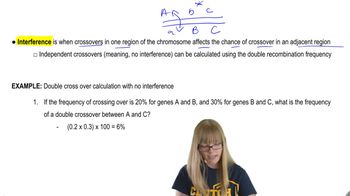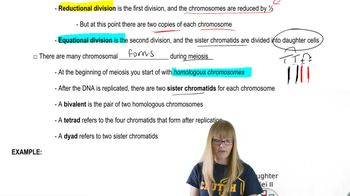Cohesion between sister chromatids, as well as tension created by the pull of kinetochore microtubules, is essential to ensure efficient separation of chromatids at mitotic anaphase or in meiotic anaphase II. Explain why sister chromatid cohesion is important, and discuss the role of the proteins cohesin and separase in sister chromatid separation.
Table of contents
- 1. Introduction to Genetics51m
- 2. Mendel's Laws of Inheritance3h 37m
- 3. Extensions to Mendelian Inheritance2h 41m
- 4. Genetic Mapping and Linkage2h 28m
- 5. Genetics of Bacteria and Viruses1h 21m
- 6. Chromosomal Variation1h 48m
- 7. DNA and Chromosome Structure56m
- 8. DNA Replication1h 10m
- 9. Mitosis and Meiosis1h 34m
- 10. Transcription1h 0m
- 11. Translation58m
- 12. Gene Regulation in Prokaryotes1h 19m
- 13. Gene Regulation in Eukaryotes44m
- 14. Genetic Control of Development44m
- 15. Genomes and Genomics1h 50m
- 16. Transposable Elements47m
- 17. Mutation, Repair, and Recombination1h 6m
- 18. Molecular Genetic Tools19m
- 19. Cancer Genetics29m
- 20. Quantitative Genetics1h 26m
- 21. Population Genetics50m
- 22. Evolutionary Genetics29m
9. Mitosis and Meiosis
Meiosis
Problem 8
Textbook Question
Suppose crossover occurs between the homologous chromosomes in the previous problem. At what stage of M phase do alleles D and d segregate?
 Verified step by step guidance
Verified step by step guidance1
Understand the context: The problem involves the segregation of alleles D and d during meiosis. Meiosis is a specialized cell division process that reduces the chromosome number by half and involves two stages: Meiosis I and Meiosis II.
Recall the principle of segregation: Alleles segregate during meiosis when homologous chromosomes are separated. This occurs during Anaphase I of Meiosis I, where homologous chromosomes (each carrying one allele) are pulled to opposite poles of the cell.
Consider the role of crossover: Crossover occurs during Prophase I of Meiosis I, where homologous chromosomes exchange genetic material. This does not affect the segregation of alleles D and d, as segregation is determined by the separation of homologous chromosomes.
Identify the specific stage: The alleles D and d segregate during Anaphase I of Meiosis I, as this is when homologous chromosomes (each carrying one allele) are separated and move to opposite poles.
Conclude the reasoning: The segregation of alleles D and d is a direct result of the separation of homologous chromosomes during Anaphase I, regardless of whether crossover has occurred earlier in Prophase I.
 Verified video answer for a similar problem:
Verified video answer for a similar problem:This video solution was recommended by our tutors as helpful for the problem above
Video duration:
3mPlay a video:
Was this helpful?
Key Concepts
Here are the essential concepts you must grasp in order to answer the question correctly.
Crossover
Crossover is a genetic process that occurs during prophase I of meiosis, where homologous chromosomes exchange segments of genetic material. This exchange increases genetic diversity in gametes by creating new allele combinations. Understanding crossover is essential for analyzing how alleles are inherited and how they can segregate during meiosis.
Recommended video:
Guided course

Multiple Cross Overs and Interference
Meiosis
Meiosis is a specialized type of cell division that reduces the chromosome number by half, resulting in four genetically diverse gametes. It consists of two sequential divisions: meiosis I and meiosis II. The segregation of alleles occurs during these divisions, particularly during anaphase I when homologous chromosomes are pulled apart.
Recommended video:
Guided course

Meiosis Overview
Segregation of Alleles
The segregation of alleles refers to the separation of different alleles of a gene during gamete formation. According to Mendel's law of segregation, alleles for a trait segregate independently into gametes during meiosis. In the context of the question, alleles D and d segregate during anaphase I of meiosis when homologous chromosomes are separated.
Recommended video:
Guided course

New Alleles and Migration
Related Videos
Related Practice
Textbook Question
578
views


